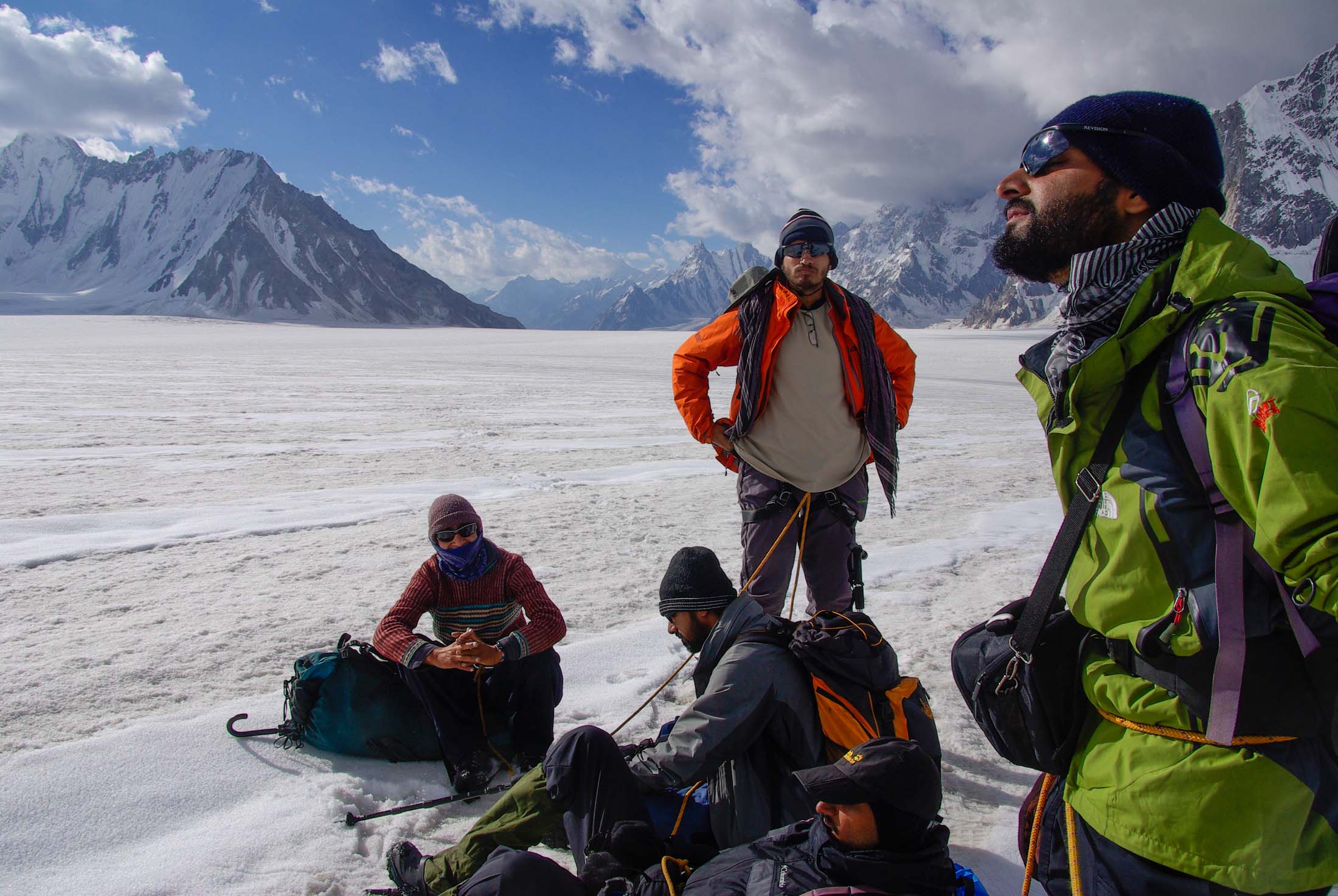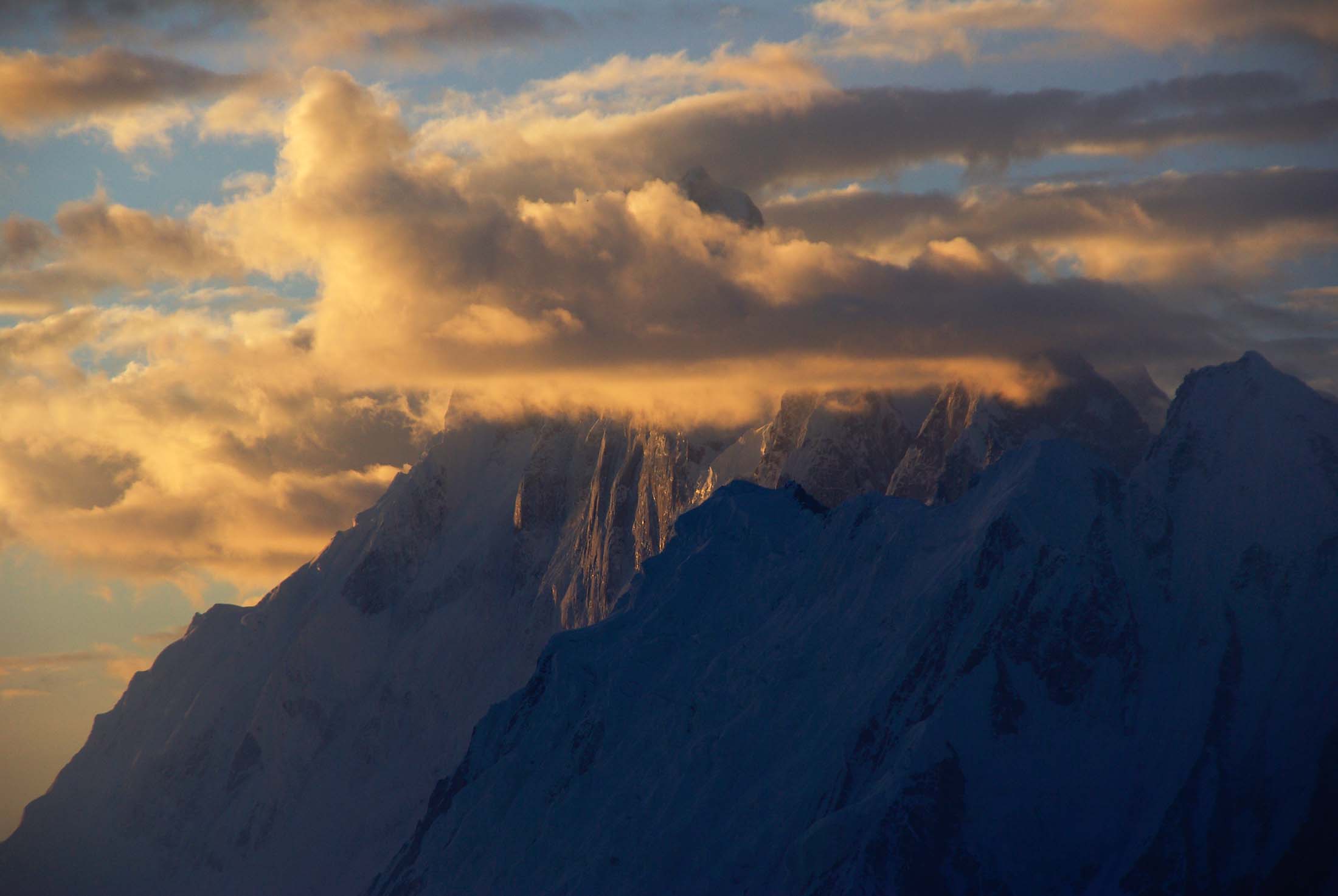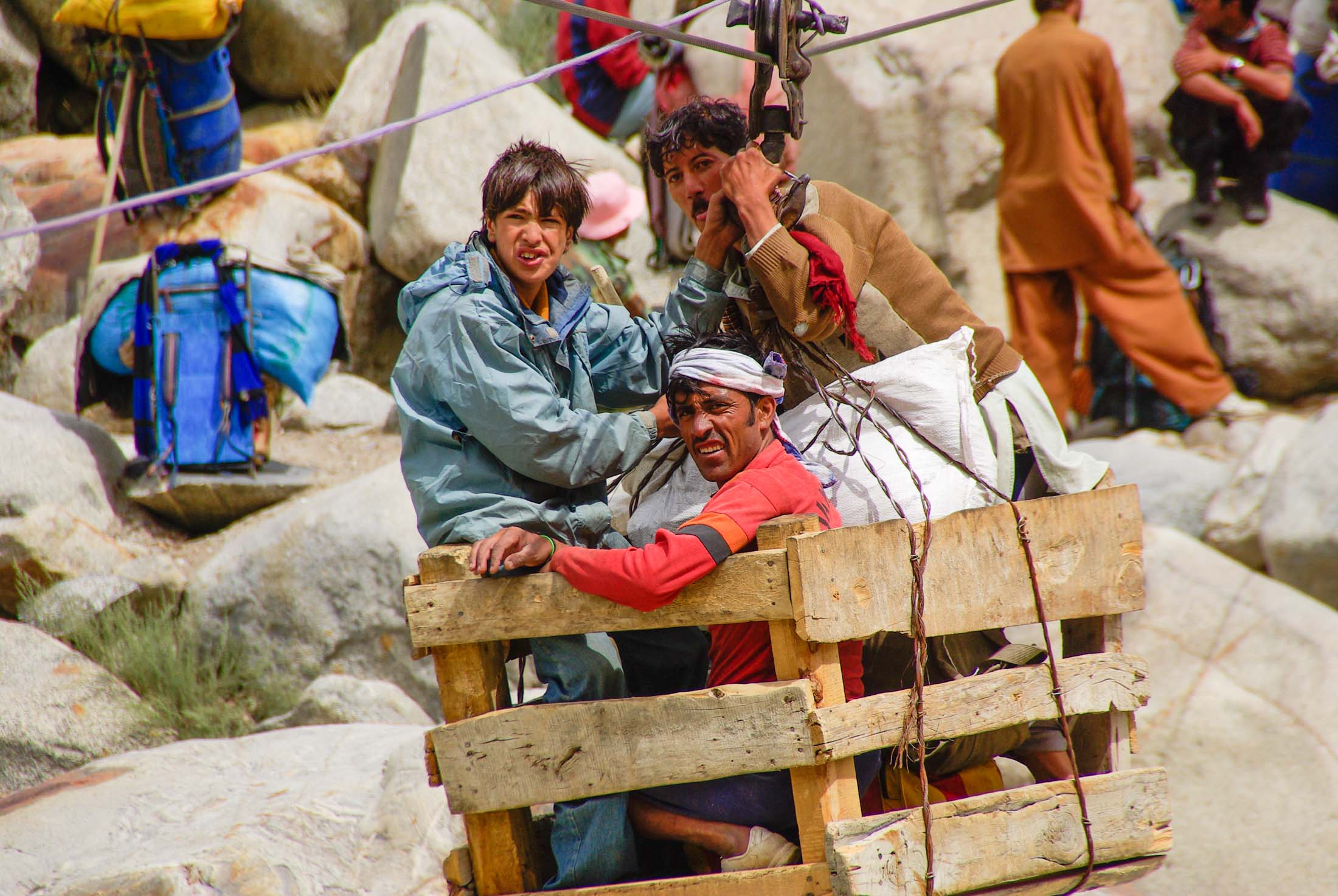perex
HOW DOES IT FEEL TO BE BORN IN PAKISTAN AND HAVE A THING FOR CLIMBING AND WALKING THE MOUNTAINS? DO YOU EVEN HAVE A CHANCE IN A COUNTRY RUN BY STRICT TRADITIONS? “FOR SURE!” SAYS PAKISTANI – AMAD JUNAID.
Kredity
TEXT: Natalie Sirova PHOTO: Amad Junaid (bw), Sun Yan form Nanjing (color), PROOFREADING: DANIEL RABER
| FEBRUARY 2017
Text 1
He was always on time at a climbing gym. I was usually late. I met Amad Junaid from Pakistan during my apprenticeship in Munich, Germany, where he has been studying and working for more than a year now. When Amad started telling me about the mountains and the life in Pakistan during our trek in the Bavarian Alps, more and more questions started to come up.
PAKISTANIS ARE CURIOUS, CLIMBING AREAS ARE ON THE RISE
Could you generally describe the climbing scene in Pakistan? How do local people feel about climbing?
Climbing is itself not new in Pakistan. People belonging to the mountainous regions have always been supporting western climbers and mountaineers since exploration began in the Himalayas and the Karakoram in the 19th and 20th century. In these areas, you can always find good local mountaineers and guides. The infrastructure is still lacking in a lot of aspects due to very little support from the government. One can always get to a mountain or a crag but bad roads and lack of regulations makes it very time consuming and logistically difficult.
Does Pakistan have its own climbing community?
The climbing community is small and in its early years now but great things can be expected of it in the next 5-10 years. An example is that within the last 3-4 years many routes have been bolted in the Margalla Hills (part of the lesser Himalayas) around the capital Islamabad. The hills can be easily reached in 10-20 minutes and now some climbers practice there regularly.
Another big milestone came just last year when the first Pakistani team scaled the Trango Towers in the Karakoram (world tallest rock towers offering some of the most challenging rock climbing, the summit of the Great Trango Tower reaches the height of 6,286 m).
How many people in Pakistan actually participate in climbing or mountain hiking?
I would say about 5% people go for hiking and for climbing it is less than 1%. The majority of the population in Pakistan belongs to plateau areas so climbing is fairly new for them. They are sceptical because of safety concerns but they are also curious enough to try and learn it.
Are there any indoor climbing facilities in Pakistan?
There is no indoor climbing gym and the hot weather, which lasts about 7-8 months, will not work in favour of indoor climbing in Pakistan. Some outside climbing walls or towers have been built in the past couple of years. These are very few (1 in Lahore and 2 in Islamabad) but still because of these arenas, small climbing clubs have also started that organize training and competitions.
BANNER
Text 2
Is there a climber you admire?
There are a lot but I will try to keep it concise and relevant. I admire Imran Junaidi and Usman Tariq who completed the first Pakistani expedition on Trango Towers in 2014. These pioneers of Pakistan big wall climbing also established routes in the Margalla Hills around Islamabad and run the Alpine Institute Pakistan. I admire them because their efforts have made this activity more accessible in Pakistan.
I am heavily inspired by Tony Kurz and Andreas Hinterstoisser because of their efforts on north face of the Eiger in 1936. I also like Thomas Huber from Germany who was part of the team, which did the second ascent of the challenging Pakistani seven-thousand-meter peak Baintha Brakk (more in the infobox below). I like to follow Adam Ondra (Czech Republic) and David Lama (Austria) as their climbing projects are always interesting.
You and your friends went on a trek through the Karakoram. What made it special?
Our objective was to cross the Lukpe Lawo (also called Snow Lake) located 4,877 m above sea level in the Karakoram. It is not an actual lake but a glacial basin out of which Biafo glacier (3rd longest glacier outside the polar region) and Hisper glacier flow. It connects the ancient mountain kingdoms of Hunza and Baltistan. It is really special because of its immensity – it is 16 km long and together with the both glaciers it creates the longest glacial traverse (110 km) outside of the poles.
Galerie 1
Text 3
OTHER GLACIERS FLOW INTO THE HISPAR WITH A GREAT SPEED
Where did your trek begin? How long did it take to reach the Lukpe Lawo?
Starting at about 3000 m, the first 5 days of the trek took us across the Biafo glacier (67 km long and 5 km wide). There are established campsites along the edges of the glacier, which require roughly 6-7 hours of hiking each day. The glacier is bordered by a large number of pointy Karakoram peaks, which are mostly above 6000 m high. Some of the notable peaks are the Latok group, Uzum Brakk and Baintha Brakk.
As we moved up the glacier, the environment turned from lush green to sandy and later to rocky campsites. We spent one whole day crossing the width of the Biafo glacier, which was particularly challenging as we had to climb down and up again on the very unstable and steep moraine on the edges and in the middle we had to avoid gigantic crevasses so we took quite long detours. On the 6th day we reached the edge of the Lukpe Lawo where we turned west and climbed up the Hispar pass (5150m) and spent the night there. There one can really appreciate the gigantic expanse of snow and ice.
How did it go from there?
While the Biafo is mostly a smooth ice highway, the Hispar glacier is a mess of churned and twisted ice as 5 different glaciers flow into it on its northern side at a remarkable pace making it impossible to walk on the glacier. There is no track on the southern edge as it is lined with snow covered avalanche prone 7800m peaks. We traversed through the campsites on the north edge and crossed the glaciers along the way, which was particularly taxing because of strenuous boulder hopping and steep hillside lateral moraines. It took us 4 days to get to the Hispar village from where we got a Jeep to Karimabad, Hunza.
There are other well-known treks in Pakistan. Why did you choose this one?
The thing that makes this place really unique is that only about 200 people per year visit it which helps in keeping the trek closer to nature, unlike the K2 basecamp Baltoro trek which is now littered heavily in the summers with people and machinery. It showed us the truest meaning of being in the wild.
Who was in the team? Did you hire a guide?
We were 4 friends joined by a Chinese girl who was trekking in Pakistan for the last 3 months. We had hired porters, a cook and a guide, who carried supplies, cooked and managed the trek. These were local Baltistani people who have a century long tradition of helping and hosting adventure seekers. A porter is charged to carry at least 25 kilos. Our own rucksacks were 8-10 kilos each. At the end of the trek we had become a huge family, joking and jesting with each other and sharing the sense of achievement that the trek was finally over.
full width fotka
Mapa
Satellite view of the Biafo glacier (SE) and Hispar (NW)
Text 4
Was it dangerous? What was the most difficult part for you?
I would not call it dangerous but you have to listen to the guide if it is your first trip in the Karakoram. The crevasses can prove dangerous if you are not experienced in glacial hiking. The part when we crossed over and climbed up the Hispar pass is particularly hazardous as it contains a lot of hidden crevasses, so we roped together to climb up and down the pass.
Two occasions were particularly difficult for me but I am sure it was because I am not a very experienced hiker myself. The first point was when we hiked up the Hispar pass as on that day we started at about 4500m and reached 5100m. This was my first time at such a height and I felt particularly tired. The next hard section was when we crossed two glaciers (Jutmaru and Pumari Chish) while hiking along the Hipsar glacier, which meant we were scrambling up and down the boulders and unstable moraine the whole day.
Is it necessary to hire a guide for such treks?
It would be necessary if you are novice to expedition style trekking and have only done alpine style hikes. If you have been a couple of times to the Himalayas or the Karakoram already then it can be attempted although it would mean you would need to be more careful, carry more luggage (mostly food for 10-12 days). You will need to do the logistics (like hiring porters and Jeeps etc.), which is not easy for someone who is not familiar with the culture and the language.
How do people in Pakistan feel about foreign climbers or tourists? Is hospitability part of the culture?
As climbing is still considered a foreign activity in Pakistan, it is very exciting for locals to meet foreign climbers and tourists. Mostly people tend to like foreign tourists and can spend hours talking to them about their culture. It is very common to receive invitations for dinners or lunches from the locals but it is a very conservative country so spending some time to read about it will certainly help. The culture is mainly an amalgamation of Islamic religious tradition and the Indian social values. It is very easy for a foreigner to misinterpret certain situations. One thing to note is that culture changes drastically in different areas in Pakistan. There are people of Gilgit and Baltistan region who have been hosting foreign expeditions for the past 150 years and then there are villagers in the remote mountains that will consider even another Pakistani from the planes of Punjab a foreigner. The number of languages spoken in Pakistan can give an idea of how diverse the culture can get while travelling in Pakistan but Urdu is spoken and understood by all.
Is Pakistan safe for foreigners?
Pakistan is safe for foreign climbers and travellers. The Gilgit-Baltistan region is one of the most peaceful areas in Pakistan and personally I can say that I have felt safer in Skardu than in Islamabad or Lahore. It is incidentally also one of the most educated and enlightened regions of Pakistan. I personally know a Chinese friend who travelled in Pakistan for about 3 months alone. She travelled through some of the places, which are now famous for being unsafe. One example is the city of Peshawar (photos are below).
Galerie Cina
Text 6
What do you think about the killing of 10 climbers in 2013 in the north of Pakistan that has been ascribed to the Taliban terrorist organization?
The killing of 2013 was a very sad incident, which could have proven to be a deathblow to mountaineering in Pakistan if it were not for some brave and courageous foreign adventure seekers who kept coming back. Militancy in Pakistan is based on a twisted mentality that by no means can be taken for a just cause, which led the terrorists to kill 10 mountaineers. The Gilgit-Baltistan region (which is where all expeditions start) itself has no indigenous militancy issue.
Did the government implement any safety measures?
Some measures taken by the authorities provide a good sense of security. An armed escort is provided to every transportation vehicle on the less safe part of the Karakoram Highway (i.e. Mansehra to Chilas). Policemen were provided to guard and escort the mountaineers in this winter attempt (2014/15) on Nanga Parbat. This year, the local police department also announced a formation of high altitude police force, which will be trained specifically (by mountaineers and climbers) to assist and safeguard mountaineering and climbing activities in the region.
I believe, most people in Pakistan do not support violence, how do they feel when something like this happens?
Your belief is obviously correct. Their feelings are always quite apprehensive against such things. Along with international defamation, local businesses also get greatly affected by this and this spreads a continuous fear among the community.
What do you think are the main differences between hiking in the Alps and hiking in the Himalayas, the Karakoram or the Hindu Kush?
There are two main differences that I can point out. First is the scale. The highest mountain in the Alps is Mt. Blanc (4810m). The Hispar pass we crossed was at 5100m with many 7000m peaks around it. There are 128 peaks in the Alps above 4000m. In Pakistan there are 108 peaks above 7000m, many of them unclimbed. Nobody bothers to count peaks above 6000m. The longest glacier in the Alps is the Aletsch Glacier (23km). The longest glaciers in the Karakoram are Siachen (76km), Biafo (67km) and Baltoro (63km).
There is hardly any 1-day trek in the Himalayas or the Karakoram. Usually, you have to be ready to be camping and hauling gear for 3-4 days even on the smallest of treks. The second difference is the lack of infrastructure, which makes it hard to plan a trip. In the Alps you can get to places easily and do not need to plan much. It is an inconvenience but also a blessing as the places in Pakistan stay untouched by people and you really can escape from civilization there.
_
_
Special thanks to Tendon Ropes for their help with English translations.
.
Citát
“Nobody bothers to count peaks above 6000m in Pakistan.”
Infobox pěkný s fotkou v bgr
A 7,285m granite tower on Biafo Glacier with a notorious history (only three ascents in the history with a 24-year gap and 20 failed attempts between the first two ascents). It is particularly difficult because technical rock climbing is needed at the altitude above 7,000m.
A system of granite rock towers in the heart of the Karakorams with peaks at 6,231m and 6,286m. They have been climbed many times and have well-established routes.
A 16km wide expanse of snow at the confluence of Biafo and Hisper glaciers. A number of treks can be undertaken here, none of which take less than 10 days to complete.
A 6,422m rock tower shaped perfectly like a dagger jutting out of the Biafo glacier first ascended in 2013 by Czech climbers Jirka Plisek and Ondra Mandula.
Concordia is a region in the Karakoram with a concentration of world’s highest peaks with four 8,000ers (K2, G1, G2 and Braod Peak). It can be reached via traversing the Baltoro glacier. The trek goes on through the pass Gondogor La at 5,940m.
This valley is more accessible and famous for its beautiful lakes and lush green meadows. It provides numerous hiking opportunities with some longer treks of 2-3 days, which cross over to the Kashmir.
This is the second highest plateau in the world at an average height of 4,114 meters. These plains are above the tree line so there are only tiny flowers (just a few inches high), which have a very short period of bloom, but if you are lucky enough to be there, the flower-covered fields stretching up till the horizon are surreal.
A trek around the three gigantic faces of notorious 8,000er with a visit to each of the base camps.
It is a region in Chitral district. It is famous for the small community of Kalash people that reside here. Their culture traits are very unique and very well preserved. They follow a religion that is very close to nature worshiping and lead a simple village life oblivious to the changing world around them.
This is a narrow strip of land about 350km of length and was a result of border agreements between the Britain and the Soviet Union during the era of the Great Game. The deep mountain valley pressed by the Pamir from the north and the Karakoram from the south stretches along the borders of Afghanistan and separates it from Pakistan in the south and from Tajikistan in the north. This region is also interesting because of its native people: the Wakhi and the Kergyz. These communities are small in number and to this date remain isolated from the world making this region seem like the real edge of civilization.
It is one of the highest alpine lakes in the world (4,694m) at the base of Rush Pari Peak (5,098m). It takes a two-day trek from Nagar, Hunza. The hike offers breath-taking views of Spantik (7,027m), Malubiting (7,458m) and Ultar Sar (7,388m).
infobox tabulka
Autor

Natalie Sirova
AuthorHad studied Journalism and likes preparing long original interviews the most.
Comes from Giant mountains (Czech Rep.), where she runs, cycles and enjoys skiing. Likes climbing and traveling as well.

Standa “Sany” Mitac
Editor in chief“Climbing is not about the grades and life is not about the money.”
He loves to write about inspiring people.
Addicted to situations when he does not care about the time – in the mountains or sandstone crags.
















































